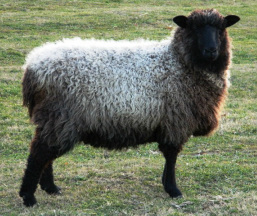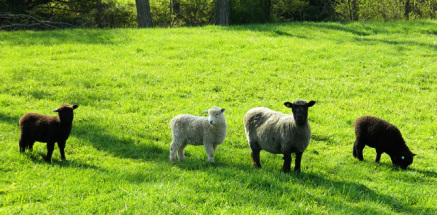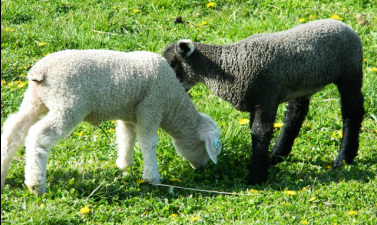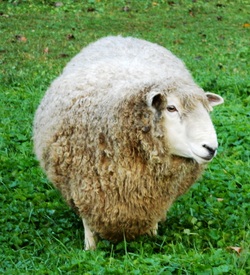Coopworth sheep are a relatively new breed that in originated in New Zealand in the 1950s as a cross of Border Leicesters and Romneys. They are dual purpose sheep of medium size. Coopworths are highly prolific and thrive on pasture grasses. Their wool features a well-defined crimp, with high luster and pointed locks, and a staple length of six to eight inches. In the 1970s, Coopworths began to be imported into the United States.

The Flock at Arbormeadow
We have white and natural-colored sheep in our flock. All of our white Coopworths, rams as well as ewes, carry the genetic potential for producing natural-colored offspring. We are gradually integrating increasing numbers of natural-colored ewes into our flock in an effort to maintain a more-or-less even balance of white and natural colored ewes.
We have white and natural-colored sheep in our flock. All of our white Coopworths, rams as well as ewes, carry the genetic potential for producing natural-colored offspring. We are gradually integrating increasing numbers of natural-colored ewes into our flock in an effort to maintain a more-or-less even balance of white and natural colored ewes.

Our natural-colored ewes show color variations ranging from shades of pewter to bluish gray, and from tobacco-like hues of medium brown to dark chocolate brown. Some fleeces are mottled in color and include variation of color within the individual fleece. Adding to the variety of color is that the tips of parts of fleeces are sun-bleached.

Although Coopworths are numerically dominant in our flock we also raise a few Romney sheep in order to develop our own Coopworths (through the American Coopworth Registry’s “upgrade” program) and to introduce new variations of color and texture into our fleeces. As a result, our flock also includes a few Coopworth/Romney crosses. Shown here, are Millie, a Romney ewe, and her spring 2013 triplet crosses (from left, Teasel, Dewberry, and Tobo).

Our sheep are raised humanely and naturally.
We breed our ewes in late October or early November, shear the flock in mid-March, and lambing begins in late March or early April. Our sheep graze pastures year-round but in the winter, when grass is scarce, we give them high-quality hay. We feed grain, usually corn, to our ewes only for a few weeks during breeding season to provide a nutritional boost and during the last weeks of gestation when they are unable to consume enough hay to give them adequate nutrition. Our lambs are grass-fed. They grow solely from the milk provided by their mothers and the grass in our pastures.

Louie, Our First Coopworth Ram
A ram contributes half of the genetics to the continuing development of a flock and so he is one of its most important members. In September 2011, when we began our venture with Coopworth sheep, we purchased a breeding trio that included “Louie” (pictured here), a two-year-old ram who had been born (as a nine-pound quadruplet) on a farm in West Virginia. He has sired many natural-colored as well as white lambs, some of which are now members of our breeding flock. A son of Louie, named Dutch, has also served as one of our rams, but we sold him this summer and so now he is with a Coopworth flock in central Virginia. Our current rams are Augustus (a son of Louie), and Pendleton, a ram from West Virginia.




